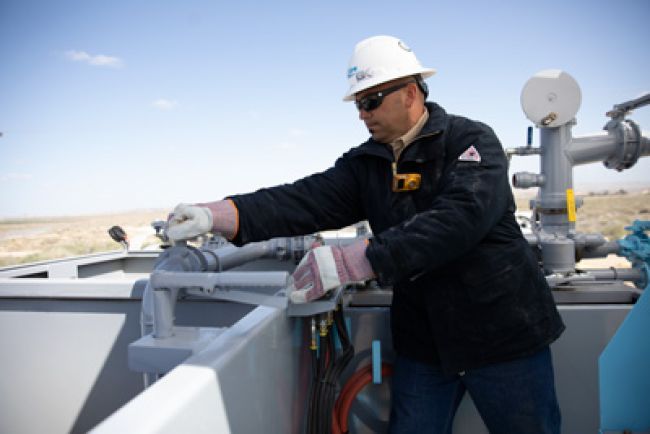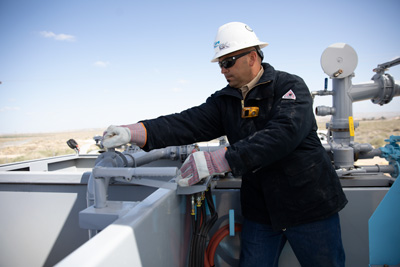
Mother Nature vs. FR/AR Clothing

The company I work for receives a lot of questions about flame-resistant (FR) and arc-rated (AR) clothing, including inquiries about what should be worn on extremely hot summer days and very cold winter days. We’re always happy to answer those questions because it’s our business and – in the electric utility industry – donning FR/AR apparel often is necessary for workers’ personal safety.
The fact is, extreme weather doesn’t appear to be stabilizing anytime soon. Both NASA and the American Meteorological Society have predicted that we can expect both more intense and more frequent heat and cold events across the country in the coming decades, with implications for both indoor and outdoor workers.
Given that information, it’s important that workers know what heat stress and cold stress are and what those types of stress can do to their bodies. So, let’s discuss some definitions of heat and cold stress, what can contribute to them, and what employers and workers can do to address them – including participating in a strong FR/AR clothing program.
Heat and Cold Stress
Heat stress occurs when the body cannot rid itself of excess heat. According to the National Institute for Occupational Safety and Health, heat stress “can result in heat stroke, heat exhaustion, heat cramps, or heat rashes. Heat can also increase the risk of injuries in workers as it may result in sweaty palms, fogged-up safety glasses, and dizziness.”
Further, when the ambient temperature is greater than a person’s body temperature, radiation, conduction and convection struggle to cool the body. That leaves evaporation of perspiration – more commonly known as sweating – as the body’s only cooling mechanism. And if the body does not receive ample fluids, just being dehydrated as little as 3% has shown as much as a 17% reduction in an individual’s reaction time, which also can lead to accidents.
To help prevent the onset of heat stress, following are some basic recommendations for employees tasked with performing work in high temperatures:
- Boots should be lightweight yet protective.
- Head protection should incorporate shade when possible.
- Hand protection should incorporate lightweight, breathable material when possible.
- Schedule jobs for cooler parts of the day.
- Limit the amount of time spent outside on extremely hot days and move to cool locations during breaks.
- For long, demanding jobs, use relief workers or assign extra workers.
- Make sure there is ready access to cold beverages; try to avoid those with caffeine and sugar.
- Eat regularly to keep up your energy, but avoid heavy foods that are hard to digest.
- Avoid touching hot metal surfaces with your bare skin.
- Monitor your physical condition and that of your co-workers. Speak up if you see anyone having difficulties, such as sweating heavily, looking pale, experiencing nausea or vomiting, or feeling dizzy.
On the other end of the spectrum is cold stress, which occurs when a person’s internal body temperature drops. When it’s cold at a job site, the temperature begins to eliminate the insulative capabilities of clothing – including FR/AR apparel – and increases a person’s risk of contracting hypothermia and other cold-related illnesses.
To help ensure worker safety in the cold:
- Boots should be insulated and waterproof.
- Head protection should incorporate insulation.
- Hand protection should be waterproof and incorporate lightweight insulation.
- Schedule jobs for warmer parts of the day.
- Limit the amount of time outside on extremely cold days and move to warm locations during breaks.
- Use relief workers or assign extra workers for long, demanding jobs.
- Make sure there is ready access to warm beverages.
- Avoid touching cold metal surfaces with your bare skin.
- Monitor your physical condition and that of your co-workers. Speak up if you see anyone experiencing difficulties, such as reddening of the skin, disorientation or loss of coordination.
Be mindful that there are some factors that can make individuals more susceptible to heat- and cold-related illnesses, including age; overall health and fitness levels; body mass index; alcohol and/or caffeine use; use of certain medications; diet; hydration/dehydration levels; and exertion level.
The critical point to understand is that – if left unchecked – employee exposure to extreme temperatures can lead to various medical conditions, including severe and life-threatening heat stroke and hypothermia.
FR/AR Clothing
One of the ways employers can help workers battle heat and cold stress – as well as the risk of burn injury from a flash fire or an arc flash – is to provide them with appropriate FR/AR clothing. No perfect garment exists for either hot or cold temperature extremes, however, so you’ll need to do your research to find the fiber and fabric options that will provide your workers with the optimal balance of protection and comfort.
You should know that single-layer FR/AR clothing does not trap heat or restrict heat removal any more than regular non-FR clothing does. A person primarily sheds heat through evaporation of sweat once the air temperature is greater than their body’s temperature. When the ability to sweat is restricted, however, or when it is lost altogether – either due to physiological conditions, such as dehydration, and/or clothing that restricts this action, such as raingear – the possibility of heat stress increases.
Fortunately, advancements in textiles available in today’s FR/AR garments offer improved performance in extreme temperatures. For instance, moisture management is one advancement that assists in keeping the user comfortable. In hot temperatures, lightweight FR/AR garments allow more heat to be released because they provide less insulation. The open weave allows more air to pass through the garment and assists in moisture evaporation, which, when combined with the garment’s moisture-wicking properties, moves more moisture to the surface of the clothing for evaporative cooling.
In the cold, lightweight FR/AR garments provide the ability to layer and increase insulation, allowing for greater heat retention. In these circumstances, an open weave allows more air to pass through, which assists in regulating body temperature and minimizing sweating. Garments with moisture-wicking properties move more moisture from the body to the surface, keeping the skin dry and helping to maintain the body’s core temperature.
If you choose to layer FR/AR clothing to combat the cold, opt for loose-fitting, lightweight garments. For example, you may want to wear an inner layer of synthetic material to keep moisture away from the body; a middle layer of wool to absorb sweat and provide insulation; and an outer layer of tightly woven, water-repellent material to help block wind and allow ventilation. Note that wool and silk inner layers hold body heat better than cotton does.
With that said, take note that undergarments can only be made of natural, non-melting fibers, per industry standards. And while layering of non-melting, flammable garments under FR/AR garments is permitted, the arc rating of the outermost FR/AR layer must be great enough to prevent break-open and ignition of any flammable underlayers. If the outer layer’s rating is not equal to or greater than the hazard, underlayers also must be arc rated. Look for outerwear that has been tested to your hazard and the appropriate standards: ASTM F1506 for arc flash and/or NFPA 2112 for flash fire for traditional insulated jackets, sweatshirts, hoodies and similar garments, and ASTM F2733 for flash fire and/or ASTM F1891 for arc flash when evaluating raingear. Noncompliant outerwear can pose a serious threat to an otherwise solid FR/AR clothing program.
Employer Responsibilities
Once FR/AR clothing is procured, the employer must ensure the garments are properly worn and cared for by workers to protect them from both extreme temperatures and arc flash hazards. There also are a few other responsibilities employers should be aware of related to FR/AR clothing and heat/cold stress:
- Workers must be trained on the appropriate engineering controls, PPE and work practices to reduce the risks of heat and cold stress.
- Employers must train workers on how to manage their workloads in both hot and cold environments while properly wearing their FR/AR clothing.
- Employers must acclimatize new workers, and those returning after time away from work, by gradually increasing their workload. Allow more frequent breaks as those employees build up a tolerance for working in various environments.
The Bottom Line
Working in extreme temperatures is never ideal, but there are myriad ways to help keep employees safe, from ensuring the crew stays hydrated and providing them with necessary breaks to running a strong FR/AR clothing program and training workers to get the most out of it. Don’t hesitate to turn to OSHA, NIOSH and FR/AR clothing manufacturers for answers to your questions. Do what you need to do to make sure your employees go home today – safely.
About the Author: Derek Sang, CSHEP, QSSP, is the technical training manager for Bulwark Protection. He has served the FR/AR clothing industry for more than 25 years. Reach him at derek_sang@vfc.com.
- Wood Pole Fall Restriction Device
- Project Management Safety Certification Program
- Best Practices for Using Your Aerial Device Jib to Handle Transformers
- The Hierarchy of Incidents and Learning: Part II
- Mother Nature vs. FR/AR Clothing
- Arc Flash and Face Masks
- Opinion: Looking to the Future During an Unprecedented Time
- June-July 2020 Q&A
- Motivators: To Improve Performance, Understand What Drives Your Behavior

